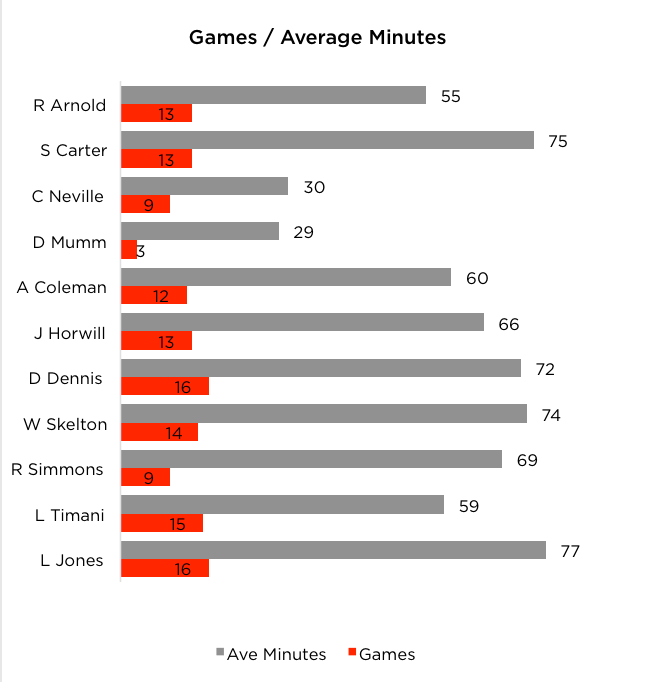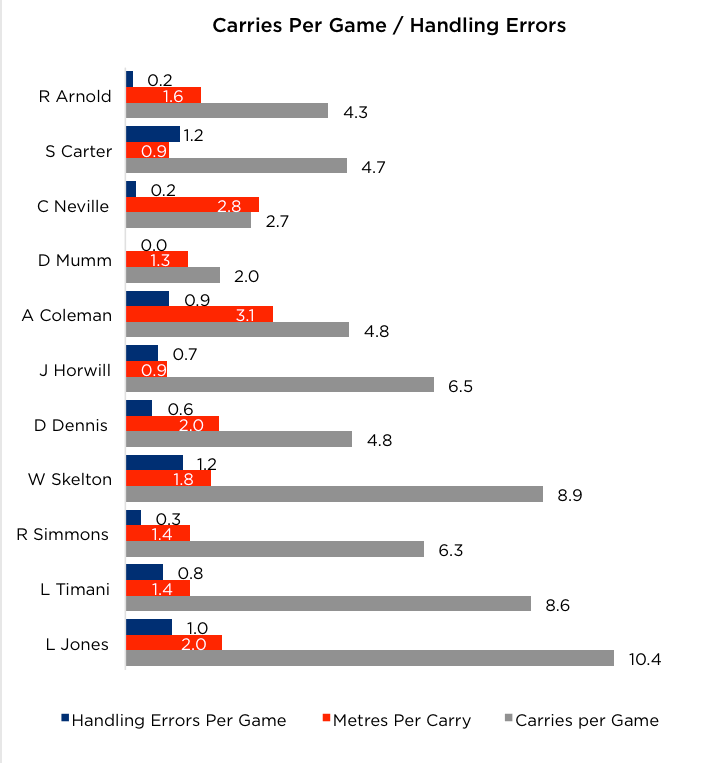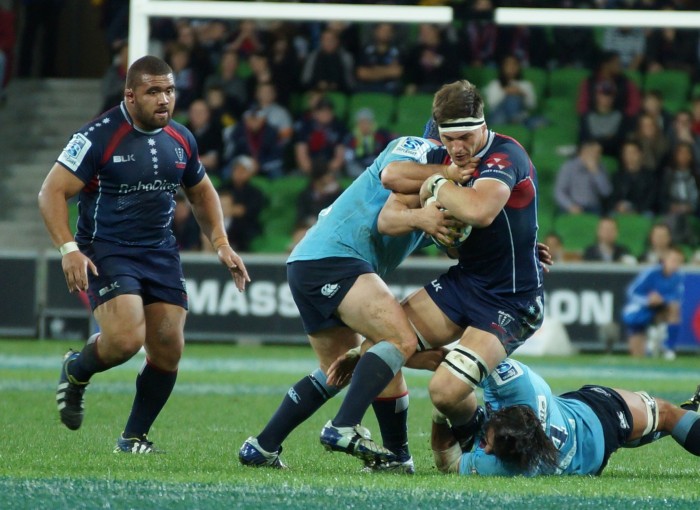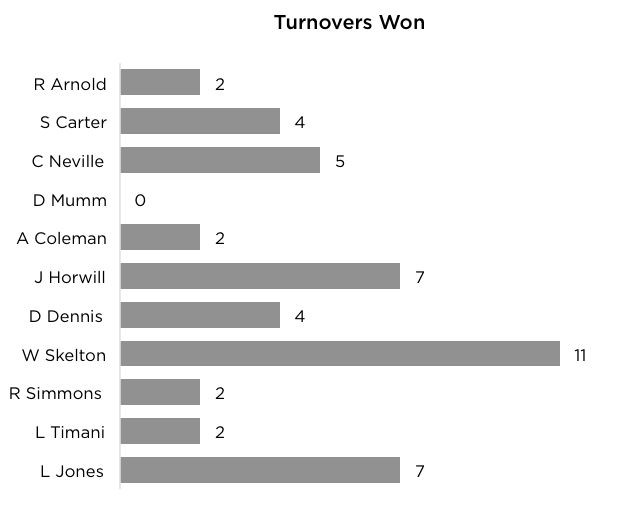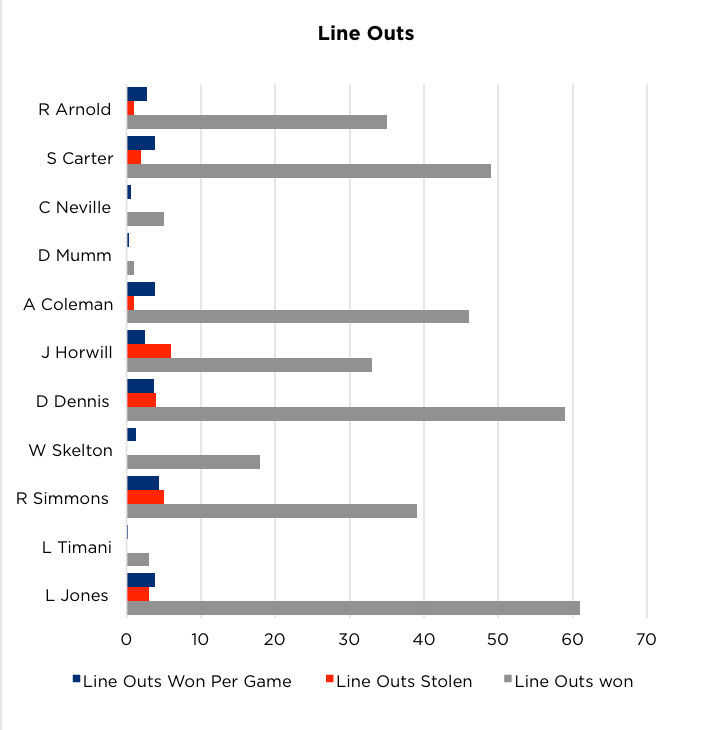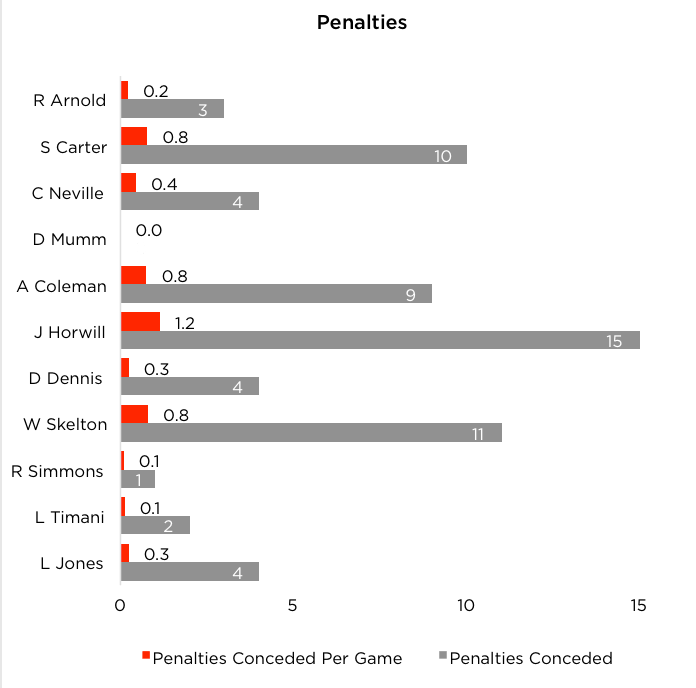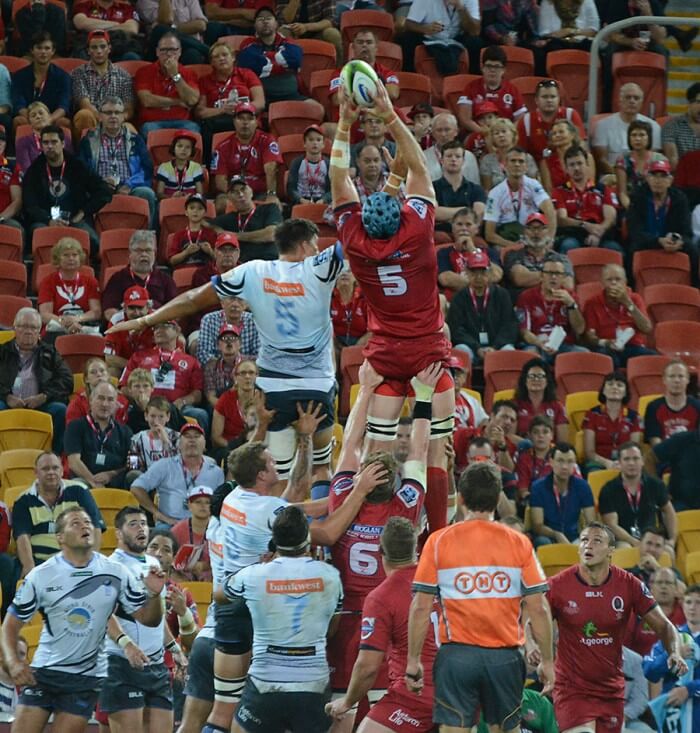With an initial Wallaby squad announced last week there has been some decent discussion in the forum on the big inclusions and omissions. One of the talking points revolves around the lock spot – particularly Lopeti Timani’s omission and James Horwill’s inclusion. I’ve attempted to do some statistical analysis of our locking candidates, specifically around their work rate. Unfortunately we are not able to compare one of the big strengths in Timani’s game, namely his impact.
Based on the likely contendors, I’ve chosen to set the field at the following options:
- Luke Jones (REB)
- Lopeti Timani (REB)
- Rob Simmons (RED)
- Will Skelton (WAR)
- Dave Dennis (WAR)
- James Horwill (RED)
- Adam Coleman (FOR)
- Dean Mum (WAR)
- Caydern Neville (REB)
- Sam Carter (BRU)
- Rory Arnold (BRU)
Information has been compiled from ESPN Scrum (minutes played) and the Vodacom Rugby App.
Game Time
The first area of comparison is one that is an even comparison, minutes played per game. This is a good comparison of what their respective teams are getting out of each candidate on a weekly basis.
Mumm and Neville were used mostly off the bench. Mumm has only made three substitute appearances (as late squad addition). Neville has been out of favour with coaching staff, starting twice (seven times as a substitute). The others are in two major categories, over 60 mins per game and 50-60 mins per game. The least experienced players (Timani, Coleman and Arnold) are in the low range. This may be a factor which Cheika considered when omitting Timani and may have also counted against Arnold.
Jones leads with 77 mins per game. The 2nd highest is Skelton, with 74 mins per game. An improvement from a player whose motor was questioned in 2014. All others are in the 65-75 min range. Timani, Coleman, Neville, Arnold and Mumm need to do more in other areas to offset this.
Attack
This is an area where a lock’s role has seemingly evolved most significantly. I’ve tried to compare the work the players are getting through, how effective it is and the errors they make whilst doing so.
The player leading the minutes per game category (Jones) also leads for runs per game with 10.5. His high rate of carries, at 2m per carry, has him the hardest working and near the most effective lock under comparison. One handling error per game is a negative, though close to most competitors.
Mumm and Neville are low in this category (and all categories) due to their limited game time. It’s difficult to compare these two as the nature of their appearances which may lead to work in short bursts. Of the remaining – Dennis, Coleman, Carter and Arnold all lag considerably in frequency, below five carries per game. Dennis’s low numbers are a surprise here when you consider he spent some time in the backrow during games which you would think would translate to a high number of carries.
Carter shows that criticism of this aspect of his play is justifiable – low for carries, low for metres per carry and highest handling errors. Horwill’s stats indicate that some criticism of him has been fair (Effectiveness – 0.9m per carry), and some wrong (lazy) with the fourth highest carries. Coleman stood out in effectiveness, with 3.1m per carry, but less than 5 carries per game. Possibly a case of him picking his involvements.
Timani is only middle of the range in this aspect with 1.4m per carry being the equal to Simmons. Skelton’s statistics tell us what we knew – he carries a lot, makes good metres but has a high number of handling errors (just like the rest of his team as Bernard Foley leads the competition here with Nick Phipps and Israel Folau also in the Top 10 also).
Reviewing ruck statistics provided by Forcefan it shows that Simmons is a stand out here, hitting 34 attacking rucks per 80 minutes, Jones (17) and the remainder hit between 18 and 22.
Defence
When discussing the work rate of players, it is important to consider both sides of the ball. We cannot objectively compare impact in defence, so I have compared their work rate (tackles) and effectiveness (missed).
Jones is a stand out here, with the highest number of tackles per game (8.5), and one of the lowest rates of missed tackles per game (missing 0.6 per game @ 93%). The remaining players fall in a fairly consistent range (5.5 to 7 per game). The next two highest tacklers, Horwill (83%) and Carter (82%), have the highest missed tackles.
The take out from this is that Jones churns through a mountain of work effectively, but Horwill and Carter must improve tackle completion to gain any benefit from their higher numbers.
Turnovers won is an area we have been able use to look at work off the ball. At James Horwill’s peak, this was a feature of his game. This season, Skelton has been a stand out here with 11, close to a turnover per game. Jones and Horwill are also strong in this area (7). Neville has been surprisingly effective (5) in his limited appearances. I don’t consider low numbers of other candidates to be a negative. The ability to win turn overs is more of a bonus from a lock, rather than a core skill.
Reviewing Forcefan’s ruck statistics Timani and Carter lead here with 7 per 80 minutes but Timani does not appear to be effective in winning turnovers from this, whilst Coleman, Skelton and Horwill are also high with 5 or more. Simmons and Arnold have nil whilst the remainder fall in the range of 3-4.Line Outs
It’s difficult for us to accurately determine the effectiveness of locks as a scrummager so I haven’t considered the scrum. Solely reviewing the work of each player in the line out.
Dennis and Jones are the main targets in their team. The Reds players, Simmons and Horwill, are slightly lower with their line out being fairly evenly distributed. Skelton has improved here, winning 1.3 line outs per game. His negative is that he has not stolen any line outs. Horwill (6) and Simmons (5) lead amongst the locks, despite not being the best in their team with Adam Thompson at 2nd in the competition with nine. This line out has stolen 27 line outs for the year, almost two a game. Multiple strong defensive options competing assists this.
Skelton needs to improve further, but only Timani stands out as a player who is inadequate, as many players having stolen as many line outs as he has won.
Discipline
As expected, Horwill leads this category, after all after giving away six penalties in Round 1 it would have been an extremely disciplined rest of the season not to finish on top. Being the only occaision he conceded more than 2 penalties in a match it may be enough to say he does not have a huge ongoing problem with discipline.
Excluding this first game, he would still have been equal 3rd for penalties conceded, so there is work to do. What the statistics looked at together tell you is that it’s likely impacted competing heavily (breakdown and line out). Skelton has a high penalty rate aligning with his physicality and breakdown impact. Simmons perceived a penalty magnet by many, conceded 1 penalty in 9 games.
Conclusion
Many will say that you cannot only look at statistics, and throw around clichés such as “Statistics are like a bikini. What they reveal is important, but what they don’t reveal is even more important”.
I agree to a point. Statistics cannot be used in isolation. Where they are beneficial is to narrow your field, and compare close candidates.
Will Skelton and Luke Jones look like our stand out lock options. They play big minutes every week, do the most work with the ball in hand and gain meters each time. Defensively, Jones is a stand out whilst Skelton is on par with other candidates. Skelton’s lower tackle rate is offset by a higher turnover rate. His only weakness has been line outs and penalties conceded.
The statistics also tell us is that Timani hasn’t been a stand out in any category and weak in minutes played and the line out. Most agree on the impact he has, but he has many of the weaknesses of Skelton in 2014. Coleman also has been weak in his ability to play solid minutes, but has been effective with ball in hand.Arnold and Carter have failed to stand out in any aspects. With Arnold in his first year and struggling to play over 60 minutes, and Carter out for an extended period due to injury, I am doubtful either player will come into calculations now.
That really leaves a further 3 strong options. James Horwill, Rob Simmons and Dave Dennis. They have fairly strong all-round games, getting through work on and off the ball whilst also being the strongest players in the line out. Simmons is considered a certainty in the squad – though it would be very difficult to leave out of the squad Australia’s most effective defensive line out jumper in James Horwill. Particularly when you consider his ability to turn over ball in the loose where he is averaging a turn over won per game. These players come with areas they also need to improve on though.
Horwill needs to minimize his penalty rate, improve tackle completion and be more effective with ball in hand, whilst Simmons needs to do more work in defence and Dennis needs to carry more.
So where does this leave us?
In the final squad I think five have put forward a strong case. Simmons and Skelton, with Jones high work rate and versatility seeing him part of the final 31 man squad also. I think the next genuine lock spot will be between Coleman and Horwill, and likely to be the player on the bench.
Cheika will weigh up Coleman’s effectiveness with ball in hand and Horwill’s ability to play more minutes and get through more work both sides of the ball. With his ability to win ball, I think that will be the edge that Horwill needs. Considering a test pack will have much stronger running options around him, reducing the usefulness of Coleman’s strengths and to balance with the strengths of the players around him, Horwill is potentially more complementary.
I see five players being in the mix because of the compelling case put forward by Dave Dennis. Previously his impact and physicality was criticised. This has improved in 2015. He has been able to play an all-round locks game, with his only weakness the amount of carries he makes. His versatility having played at lock, 6 and 8 this year, will be very valuable in a limited sized squad potentially at the expense of a specialist in another position.

